|
Greek city of
Larissa
in
Thessaly
under
Thesssalian League
Bronze Trichalkon 19mm (7.24 grams) Struck Mid – late 1st century B.C.
Python, magistrate.
Reference: Rogers 29
Laureate head of Apollo right.
ΘEΣΣA/ΛΩN, Athena Itonia striding right, hurling spear
held in her right hand, shield on her left arm; ΠVΘΩ-NOΣ
above spear, tripod in outer right field.
Following the great victory of the
Roman general ip V of Macedon, in
197 B.C., the freedom of the Greeks was proclaimed at
Corinth and a number of new autonomous coinages were
initiated. Those in the name of the Thessali were struck
probably at Larissa. The Thessalian League was a
loose confederacy of feudal-like city-states and tribes
in the Thessalian valley in Northern
Greece
and was run by a
few aristocratic Thessalian families (Aleuadae
and Skopadae). The seat of the Thessalian diet was
Larissa
.
You
are bidding on the exact item pictured, provided with a
Certificate of Authenticity and Lifetime Guarantee of
Authenticity.
A sacrificial tripod is a three-legged piece of religious furniture
used for offerings or other ritual procedures. As a seat or stand, the
tripod
is the most stable furniture
construction for uneven ground, hence its use is universal and ancient. It is
particularly associated with
Apollo
and the
Delphic oracle
in
ancient Greece
, and the word “tripod” comes
from the Greek meaning “three-footed.”

Apollo and
Heracles
struggle for the Delphic
tripod (Attic
black-figure
hydria
, c. 520 BC)
Ancient Greece
The most famous tripod of ancient Greece was the
Delphic
tripod from which the
Pythian priestess
took her seat to deliver the
oracles
of the deity. The seat was formed by a
circular slab on the top of the tripod, on which a branch of
laurel
was deposited when it was unoccupied by
the priestess. In this sense, by Classical times the tripod was sacred to
Apollo
. The
mytheme
of
Heracles
contesting with Apollo for the tripod
appears in vase-paintings older than the oldest written literature. The oracle
originally may have been related to the primal deity, the Earth.
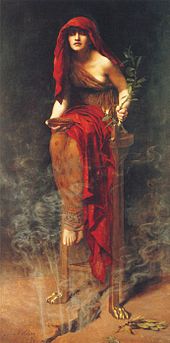
Priestess of Delphi (1891), as imagined by
John Collier
; the Pythia is
inspired by
pneuma
rising from below as she
sits on a tripod
Another well-known tripod in Delphi was the
Plataean Tripod
; it was made from a tenth part
of the spoils taken from the
Persian
army after the
Battle of Plataea
. This consisted of a golden
basin, supported by a
bronze
serpent
with three heads (or three serpents
intertwined), with a list of the states that had taken part in the war inscribed
on the coils of the serpent. The golden bowl was carried off by the
Phocians
during the
Third Sacred War
(356–346 BC); the stand was
removed by the emperor
Constantine
to
Constantinople
in 324, where in modern
Istanbul
it still can be seen in the
hippodrome
, the Atmeydanı, although in
damaged condition: the heads of the serpents have disappeared, however one is
now on display at the nearby Istanbul Archaeology Museums. The inscription,
however, has been restored almost entirely. Such tripods usually had three
ears (rings which served as handles) and frequently had a central upright as
support in addition to the three legs.
Tripods frequently are mentioned by
Homer
as prizes in
athletic games
and as complimentary gifts; in
later times, highly decorated and bearing inscriptions, they served the same
purpose. They also were used as dedicatory
offerings
to the deities, and in the dramatic
contests at the Dionysia
the victorious
choregus
(a wealthy citizen who bore the
expense of equipping and training the chorus) received a crown and a tripod. He
would either dedicate the tripod to some deity or set it upon the top of a
marble structure erected in the form of a small circular temple in a street in
Athens
, called the street of tripods,
from the large number of memorials of this kind. One of these, the
Choragic Monument of Lysicrates
, erected by him
to commemorate his victory in a dramatic contest in 335 BC, still stands. The
form of the victory tripod, now missing from the top of the Lysicrates monument,
has been rendered variously by scholars since the 18th century.
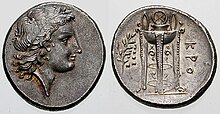
An ancient Greek coin c. 330-300 BC. Laureate head of Apollo (left)
and ornate tripod (right).
Martin L. West
writes that the sibyl at Delphi
shows many traits of
shamanistic
practices, likely inherited or
influenced from Central Asian practices. He cites her sitting in a cauldron on a
tripod, while making her prophecies, her being in an ecstatic trance state,
similar to shamans, and her utterings, unintelligible.
According to Herodotus (The Histories, I.144), the victory tripods were not
to be taken from the temple sanctuary precinct, but left there as dedications.
Sometimes the tripod was used as a support for a
lebes
or cauldron or for supporting other items
such as a vase.
-
Delphic tripod (red-figured
bell-krater
,
Paestum
, c. 330 BC)
Ancient China
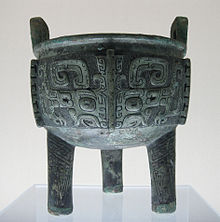
A
ding
from the late
Shang Dynasty
.
Tripod pottery have been part of the archaeological assemblage in China since
the earliest Neolithic cultures of
Cishan
and
Peiligang
in the 7th and 8th millennium BC.
Sacrificial tripods were also found in use in ancient
China
usually cast in bronze but sometimes
appearing in ceramic form. They are often referred to as “dings”
and usually have three legs, but in some usages have four legs.
The Chinese use sacrificial tripods in modern times, such as in 2005, when a
“National Unity Tripod” made of bronze was presented by the central Chinese
government to the government of northwest China’s
Xinjiang Uygur Autonomous Region
to mark its
fiftieth birthday. It was described as a traditional Chinese sacrificial vessel
symbolizing unity.

In
Greek
and
Roman mythology
, Apollo
,
is one of the most important and diverse of the
Olympian deities
. The ideal of the
kouros
(a
beardless youth), Apollo has been variously recognized as a god of light and the
sun; truth and prophecy;
archery
;
medicine and healing; music, poetry, and the arts; and more. Apollo is the son
of Zeus
and
Leto, and has a
twin
sister, the chaste huntress
Artemis
.
Apollo is known in Greek-influenced
Etruscan mythology
as Apulu. Apollo was worshiped in both
ancient Greek
and
Roman religion
, as well as in the modern
Greco
–Roman
Neopaganism
.
As the patron of Delphi
(Pythian Apollo), Apollo was an
oracular
god — the prophetic deity of the
Delphic Oracle
.
Medicine and healing were associated with Apollo, whether through the god
himself or mediated through his son
Asclepius
,
yet Apollo was also seen as a god who could bring ill-health and deadly
plague
as well as one who had the ability to cure. Amongst the god’s
custodial charges, Apollo became associated with dominion over
colonists
, and as the patron defender of herds and flocks. As the leader of
the Muses
(Apollon
Musagetes) and director of their choir, Apollo functioned as the patron god
of music and poetry
.
Hermes
created
the lyre
for him,
and the instrument became a common
attribute
of Apollo. Hymns sung to Apollo were called
paeans
.
In Hellenistic times, especially during the third century BCE, as Apollo
Helios he became identified among Greeks with
Helios
,
god of
the sun
, and his sister Artemis similarly equated with
Selene
,
goddess
of the moon
.
In Latin texts, on the other hand, Joseph Fontenrose declared himself unable to
find any conflation of Apollo with
Sol
among the
Augustan poets
of the first century, not even in the conjurations of
Aeneas
and
Latinus
in
Aeneid
XII
(161–215).
Apollo and Helios/Sol remained separate beings in literary and mythological
texts until the third century CE.
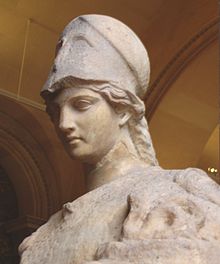
Helmeted Athena with the cista and Erichthonius in his serpent form.
Roman, first century (Louvre
Museum)
In
Greek religion
and
mythology
, Athena or Athene, also
referred to as Pallas Athena/Athene , is the goddess of wisdom, courage,
inspiration, civilization, law and justice, just warfare, mathematics, strength,
strategy, the arts, crafts, and skill.
Minerva
is the
Roman goddess
identified with
Athena.
Athena is also a shrewd companion of
heroes and is the
goddess
of heroic endeavour. She is the
virgin
patroness of
Athens
. The Athenians founded the
Parthenon
on the Acropolis of her namesake
city, Athens (Athena Parthenos), in her honour.
Athena’s veneration as the patron of Athens seems to have existed from the
earliest times, and was so persistent that archaic myths about her were recast
to adapt to cultural changes. In her role as a protector of the city (polis),
many people throughout the Greek world worshiped Athena as Athena Polias
(Ἀθηνᾶ Πολιάς “Athena of the city”). The city of
Athens
and the goddess Athena essentially bear
the same name,
“Athenai” meaning “[many] Athenas”.
Patroness
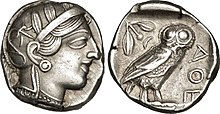
Athenian
tetradrachm
representing the
goddess Athena
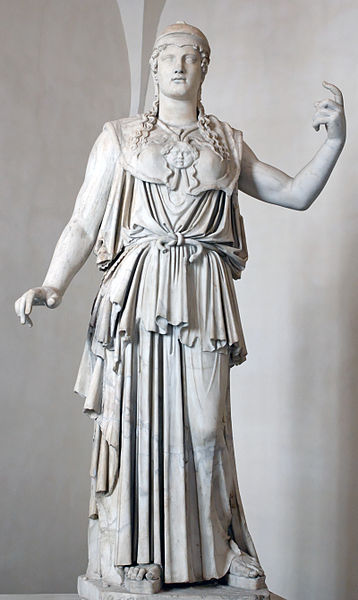
Athena as the goddess of philosophy became an aspect of the cult in Classical
Greece during the late 5th century B.C. She is the patroness of various crafts, especially of
weaving
, as Athena Ergane, and was
honored as such at festivals such as
Chalceia
. The metalwork of weapons also fell
under her patronage. She led battles (Athena
Promachos or the warrior maiden Athena Parthenos)
as the disciplined, strategic side of war, in contrast to her brother
Ares, the patron of violence, bloodlust and slaughter—”the raw force
of war”.
Athena’s wisdom includes the cunning intelligence (metis) of such figures
as Odysseus
. Not only was this version of Athena
the opposite of Ares in combat, it was also the polar opposite of the serene
earth goddess version of the deity, Athena Polias.
Athena appears in Greek mythology as the patron and helper of many heroes,
including Odysseus
,
Jason
, and
Heracles
. In
Classical Greek
myths, she never consorts with
a lover, nor does she ever marry,earning the title Athena Parthenos. A remnant of archaic myth depicts her
as the adoptive mother of
Erechtheus
/Erichthonius
through the foiled rape by
Hephaestus
.
Other variants relate that Erichthonius, the serpent that accompanied Athena,
was born to
Gaia
: when the rape failed, the semen landed on
Gaia and impregnated her. After Erechthonius was born, Gaia gave him to Athena.
Though Athena is a goddess of war strategy, she disliked fighting
without
purpose and preferred to use wisdom to settle predicaments.The goddess
only encouraged fighting for a reasonable cause or to resolve
conflict. As patron of Athens she fought in the Trojan war on the side
of the
Achaeans.
Mythology
Lady of Athens
Athena competed with
Poseidon
to be the patron deity of Athens,
which was yet unnamed, in a version of one
founding myth
. They agreed that each would give
the Athenians one gift and that the Athenians would choose the gift they
preferred. Poseidon struck the ground with his
trident
and a salt water spring sprang up; this
gave them a means of trade and water—Athens at its height was a significant sea
power, defeating the
Persian
fleet at the
Battle of Salamis
—but the water was salty and
not very good for drinking.
Athena, however, offered them the first domesticated
olive tree
. The Athenians (or their king,
Cecrops
) accepted the olive tree and with it
the patronage of Athena, for the olive tree brought wood, oil, and food.
Robert Graves
was of the opinion that
“Poseidon’s attempts to take possession of certain cities are political myths”
which reflect the conflict between matriarchal and patriarchal religions.
Other sites of cult
Athena also was the patron goddess of several other Greek cities, notably
Sparta, where the archaic cult of
Athena Alea
had its sanctuaries in the
surrounding villages of
Mantineia
and, notably,
Tegea
. In Sparta itself, the temple of Athena
Khalkíoikos (Athena “of the Brazen House”, often
latinized
as Chalcioecus) was the
grandest and located on the Spartan acropolis; presumably it had a roof of
bronze. The forecourt of the Brazen House was the place where the most solemn
religious functions in Sparta took place.
Tegea was an important religious center of ancient Greece,
containing the Temple of
Athena Alea
. The temenos was founded by
Aleus
,
Pausanias
was informed.
Votive bronzes at the site from the Geometric and Archaic periods take the forms
of horses and deer; there are
sealstone
and
fibulae
. In the Archaic period the nine
villages that underlie Tegea banded together in a
synoecism
to form one city.
Tegea was listed in Homer
‘s
Catalogue of Ships
as one of the cities that
contributed ships and men for the
Achaean assault on Troy
.
Judgment of Paris

Aphrodite is being surveyed by Paris, while Athena (the leftmost
figure) and Hera stand nearby.
El Juicio de Paris
by
Enrique Simonet
, ca. 1904
All the gods and goddesses as well as various mortals were invited to the
marriage of Peleus
and
Thetis
(the eventual parents of
Achilles
). Only
Eris
, goddess of discord, was not invited. She
was annoyed at this, so she arrived with a golden apple inscribed with the word
καλλίστῃ (kallistēi, “for the fairest”), which she threw among the goddesses.
Aphrodite, Hera, and Athena all claimed to be the fairest, and thus the rightful
owner of the apple.
The goddesses chose to place the matter before Zeus, who, not wanting to
favor one of the goddesses, put the choice into the hands of Paris, a
Trojan prince. After bathing in the spring of
Mount Ida
(where Troy was situated), the
goddesses appeared before Paris. The goddesses undressed and presented
themselves to Paris naked, either at his request or for the sake of winning.

Paris is awarding the apple to Aphrodite, while Athena makes a face.
Urteil des Paris by
Anton Raphael Mengs
, ca. 1757
Still, Paris could not decide, as all three were ideally beautiful, so they
resorted to bribes. Hera tried to bribe Paris with control over all
Asia and Europe
, while Athena offered wisdom, fame and
glory in battle, but Aphrodite came forth and whispered to Paris that if he were
to choose her as the fairest he would have the most beautiful mortal woman in
the world as a wife, and he accordingly chose her. This woman was
Helen
, who was, unfortunately for Paris,
already married to King
Menelaus
of
Sparta
. The other two goddesses were enraged by
this and through Helen’s abduction by Paris they brought about the
Trojan War
.

The Parthenon
, Temple of Athena
Parthenos
Masculinity and
feminism
Athena had an “androgynous compromise” that allowed her traits and what she
stood for to be attributed to male and female rulers alike over the course of
history (such as Marie de’ Medici, Anne of Austria, Christina of Sweden, and
Catherine the Great)
J.J. Bachofen advocated that Athena was originally a maternal figure stable
in her security and poise but was caught up and perverted by a patriarchal
society; this was especially the case in Athens. The goddess adapted but could
very easily be seen as a god. He viewed it as “motherless paternity in the place
of fatherless maternity” where once altered, Athena’s character was to be
crystallized as that of a patriarch.
Whereas Bachofen saw the switch to paternity on Athena’s behalf as an
increase of power, Freud on the contrary perceived Athena as an “original mother
goddess divested of her power”. In this interpretation, Athena was demoted to be
only Zeus’s daughter, never allowed the expression of motherhood. Still more
different from Bachofen’s perspective is the lack of role permanency in Freud’s
view: Freud held that time and differing cultures would mold Athena to stand for
what was necessary to them.
Larissa, sometimes written Larisa on
ancient coins and inscriptions, is near the site of the
Homeric Argissa. It appears in early times, when
Thessaly
was mainly governed by a few aristocratic
families, as an important city under the rule of the
Aleuadae
, whose authority extended over the whole
district of
Pelasgiotis
. This powerful family possessed for many
generations before 369 BC the privilege of furnishing
the tagus, the local term for the
strategos
of the combined Thessalian forces. The
principal rivals of the Aleuadae were the
Scopadac
of
Crannon
, the remains of which (called by the Turks
Old Larissa) are about 14 miles south west. The
inhabitants sided with
Athens
during the Peloponnesian War.
As the chief city of ancient
Thessaly, Larissa was directly annexed by Philip II of
Macedon in 344, and from then on Larissa was under
Macedonian control; in 196 B.C. Larissa became an ally
of Rome and was the headquarters of the
Thessalian League
.
Coordinates
 39°38.5′N 39°38.5′N
22°25′E
|






















